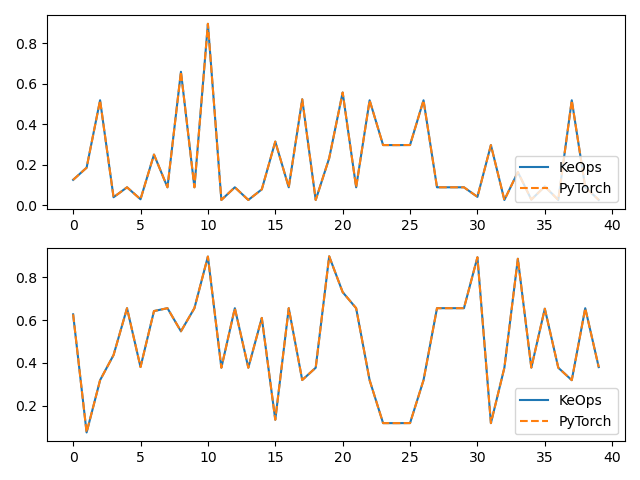Note
Go to the end to download the full example code
SumSoftMaxWeight reduction
Using the torch.Genred API,
we show how to perform a computation specified through:
Its inputs:
\(x\), an array of size \(M\times 3\) made up of \(M\) vectors in \(\mathbb R^3\),
\(y\), an array of size \(N\times 3\) made up of \(N\) vectors in \(\mathbb R^3\),
\(b\), an array of size \(N\times 2\) made up of \(N\) vectors in \(\mathbb R^2\).
Its output:
\(c\), an array of size \(M\times 2\) made up of \(M\) vectors in \(\mathbb R^2\) such that
\[c_i = \frac{\sum_j \exp(K(x_i,y_j))\,\cdot\,b_j }{\sum_j \exp(K(x_i,y_j))},\]with \(K(x_i,y_j) = \|x_i-y_j\|^2\).
Setup
Standard imports:
import time
import torch
from matplotlib import pyplot as plt
from pykeops.torch import Genred
Define our dataset:
M = 500 # Number of "i" points
N = 400 # Number of "j" points
D = 3 # Dimension of the ambient space
Dv = 2 # Dimension of the vectors
x = 2 * torch.randn(M, D)
y = 2 * torch.randn(N, D)
b = torch.rand(N, Dv)
KeOps kernel
Create a new generic routine using the pykeops.numpy.Genred
constructor:
formula = "SqDist(x,y)"
formula_weights = "b"
aliases = [
"x = Vi(" + str(D) + ")", # First arg: i-variable of size D
"y = Vj(" + str(D) + ")", # Second arg: j-variable of size D
"b = Vj(" + str(Dv) + ")",
] # Third arg: j-variable of size Dv
softmax_op = Genred(
formula, aliases, reduction_op="SumSoftMaxWeight", axis=1, formula2=formula_weights
)
# Dummy first call to warmup the GPU and get accurate timings:
_ = softmax_op(x, y, b)
Use our new function on arbitrary Numpy arrays:
start = time.time()
c = softmax_op(x, y, b)
print("Timing (KeOps implementation): ", round(time.time() - start, 5), "s")
# compare with direct implementation
start = time.time()
cc = torch.sum((x[:, None, :] - y[None, :, :]) ** 2, 2)
cc -= torch.max(cc, dim=1)[0][:, None] # subtract the max for robustness
cc = torch.exp(cc) @ b / torch.sum(torch.exp(cc), dim=1)[:, None]
print("Timing (PyTorch implementation): ", round(time.time() - start, 5), "s")
print("Relative error : ", (torch.norm(c - cc) / torch.norm(c)).item())
# Plot the results next to each other:
for i in range(Dv):
plt.subplot(Dv, 1, i + 1)
plt.plot(c.cpu().detach().numpy()[:40, i], "-", label="KeOps")
plt.plot(cc.cpu().detach().numpy()[:40, i], "--", label="PyTorch")
plt.legend(loc="lower right")
plt.tight_layout()
plt.show()

Timing (KeOps implementation): 0.00028 s
Timing (PyTorch implementation): 0.0041 s
Relative error : 1.785391248176893e-07
Total running time of the script: (0 minutes 0.125 seconds)